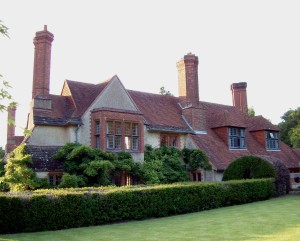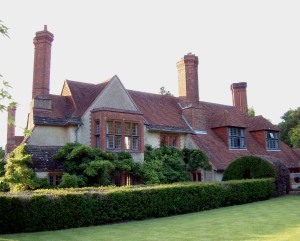Goddards
Description
Goddards


Abinger Common,
Surrey RH5 6JL
For bookings, contact:
The Landmark Trust
Shottesbrooke
Maidenhead
Berkshire
SL6 3SW
44 01628 825925
www.landmarktrust.org.uk
Surrey RH5 6JL
For bookings, contact:
The Landmark Trust
Shottesbrooke
Maidenhead
Berkshire
SL6 3SW
44 01628 825925
www.landmarktrust.org.uk
Adjacent parking
Dogs allowed
For up to 12 people
Open fire
Large enclosed garden
Goddards was built by Edwin Lutyens in 1898–1900 and enlarged by him in 1910.
It is considered one of his most important early houses, designed in the traditional Surrey style and with a garden laid out in collaboration with Gertrude Jekyll.
It is considered one of his most important early houses, designed in the traditional Surrey style and with a garden laid out in collaboration with Gertrude Jekyll.
The commission was an unusual one. In the words of Lawrence Weaver, writing on Lutyens’ houses in 1913, it was built ‘as a Home of Rest to which ladies of small means might repair for holiday’. This was the idea of Frederick Mirrielees, a wealthy businessman who had married an heiress of the Union Castle shipping line. A central range with common rooms on both floors divided two cottages, the southern of which also contained a bowling alley. Here Lutyens played a game of skittles in 1901 with the three nurses and two old governesses then staying here. They all loved the house and ‘invariably weep when they leave it’.
In 1910 Mirrielees adapted the house for his son to live in. The upper common room was divided and the cottages were extended to provide large bedrooms over a dining-room and library: two diverging wings, which hold the courtyard garden in loose embrace.
It was in a state little changed from this that the house was given to the Lutyens Trust in 1991 by Mr and Mrs M.W. Hall, its owners since 1953. The Trust, having found its care too costly, has now leased it to us, and it is once again a place to repair to for holidays and skittles. The Lutyens Trust retains the use of the Library.
Goddards stands on a little green, approached by lanes so deeply sunk as to be almost tunnels. Large estates (one of them John Evelyn’s Wootton) and the National Trust guard the surrounding country, in whose wooded landscape and brick and tile villages are concealed many masterpieces of the Arts and Crafts movement.
Part of the ground floor and the garden are open to the public by appointment only on Wednesday afternoons, from the Wednesday after Easter to the last Wednesday in October.

